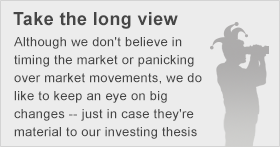
The Dow Jones Industrials (^DJI 0.57%) fell back on Monday from its record highs, but losses of less than 10 points reflected the continuing optimism among investors about the stock market's future prospects. Among the stocks helping the Dow hold steady today was JPMorgan Chase (JPM 0.03%), which climbed more than 1%. Yet even as enthusiasm about the future course of interest rates has helped to support financial stocks lately, Goldman Sachs (GS 1.34%) has introduced a bond-market innovation that could either reawaken demand for engineered financial products or bring back bad memories of the financial crisis.

Comparing Wall Street's finest
JPMorgan Chase and Goldman Sachs are both highly prestigious institutions, but they have somewhat different business models. JPMorgan has a strong reputation on Wall Street, but its Chase division has given the bank plenty of exposure to the retail side of the business. That has been a mixed blessing in recent years, as mortgage refinancing activity soared during the aftermath of the financial crisis to help bolster the bank's profits, yet billions of dollars in settlement liability against JPMorgan Chase has drawn the ire of shareholders and the public at large. Moreover, ongoing regulation has centered on fair treatment of retail banking customers, and that has limited some of the growth opportunities that investors had hoped that JPMorgan would be able to capitalize on in the future.
Goldman Sachs, on the other hand, still has its roots in corporate finance and underwriting, and that's where the institution is spending its effort these days. With even U.S. Treasury debt remaining unable to garner a coveted triple-A bond rating, Goldman Sachs has brought back some structured products that are reminiscent of the tranched asset-backed securities that infamously led to some of the biggest shocks during the financial crisis. According to a Reuters report, the new securities should get such a favorable rating by offering a combination of relatively secure assets, as well as added assurances from a Goldman Sachs joint venture that essentially gives security-holders several chances to recover their investment if something happens to the underlying assets. Similar claims made during the housing boom with respect to mortgage-backed securities proved to be incorrect, however, and so it'll be interesting to see how investors respond to the new securities despite the undeniable appetite for high-quality fixed-income investments.

At this point, JPMorgan arguably has more growth exposure, while Goldman Sachs has to demonstrate that it can overcome the headwinds that would come from a reversal in the long trend toward lower interest rates. Yet with regulators focusing both on the consumer finance segment and on ensuring fairness and safety in the securities markets, both Goldman and JPMorgan have to deal with substantial uncertainty looking forward. That makes investing in either one a risky endeavor, but also one with large potential gains.






